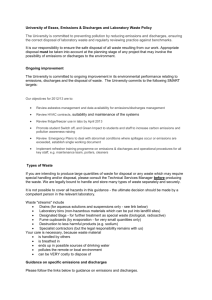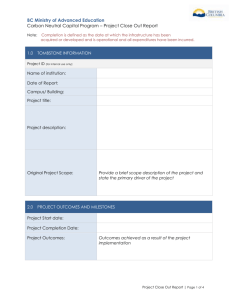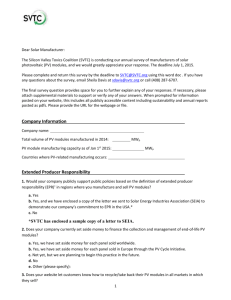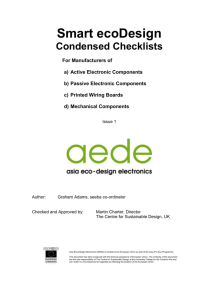Business Plan
advertisement
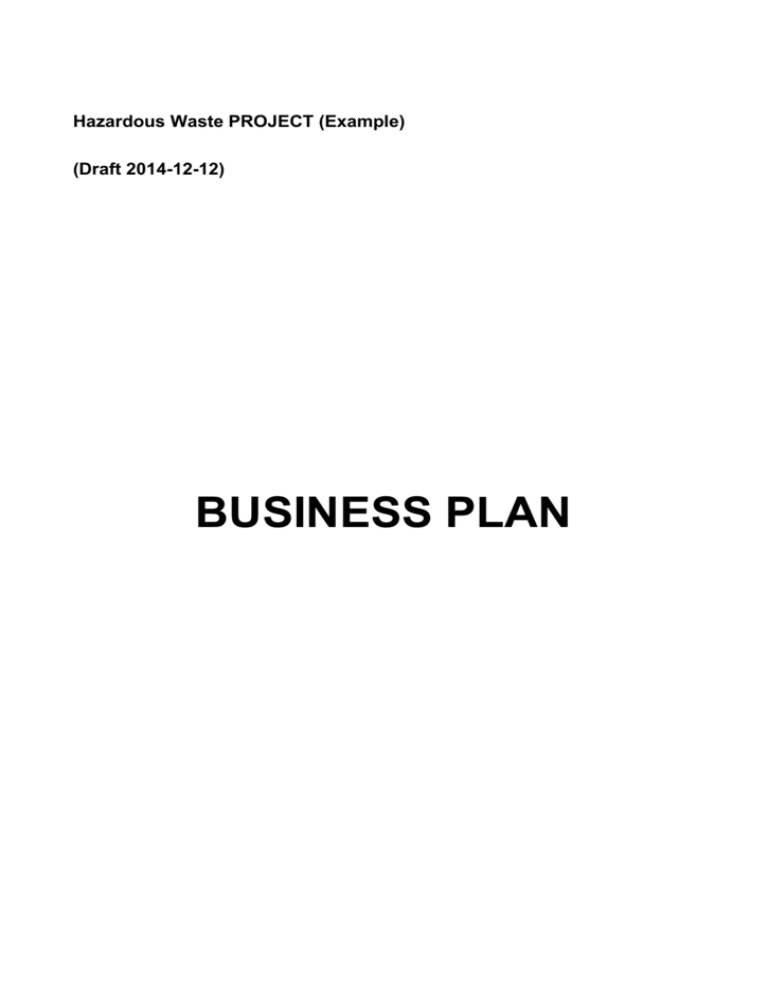
Hazardous Waste PROJECT (Example) (Draft 2014-12-12) BUSINESS PLAN CONTENTS Page Definitions Executive Summary 2.1 Shareholding structure 2.2 Sponsor profile 2.3 Brief Project description 2.4 Environmental, Health and Safety synopsis 2.5 Business/Market summary 2.6 Financing plan and Profitability 2.7 Outline of cash flow 2.8 Project implementation schedule 2.9 Summary of key risk and Issues Shareholding Structure 3.1 Principal shareholders; Private Placement: Issue Price, Offered Amount, Dividend Policy, Transfer Restrictions 3.2 Organo-gram 3.3 Details Name of the Company Contact person Address, e-mail, phone and fax numbers Legal Status and Business Registration Number History of the Company Corporate strategy Organisational structure and location Major activities and prospects Share capital and Major Owners, Terms Management Staff Banking Relationships [Balance sheet] [Income statement] Partners Sponsor Profile 4.1 Sponsor Profile 4.2 Organo-gram 4.3 Details: see 3.3 Project Information 5.1 Project Description Type of activity, production etc Present Technology, processes, major equipment/components, facilities, infrastructure etc Process Flow Diagram Hazardous Waste Inventory details, raw material, main production figures (input, output, energy consumption, destruction) Location Plant Design and Capacity Utilities and Ancillary Facilities Technology Agreement and Licenses HAZARDOUS WASTE and Raw Material Procurement and supply Purchase/Marketing Agreement Profitability Engineering Contract Warranties (Design and Engineering, Mechanical, Plant Performance) Technical Back-up Laboratory (See Environment also) Quality Control and Assurance Implementation Monitoring and Verification Project Costs Investment Time Schedule Environmental, Health and Safety Information (EHS) 6.1 Key issues on EHS: The Project to comply with the EU's Directive standards. 6.2 The primary environmental and safety impact are expected to be as follows: Energy and resource saving from recycling of metal Controlled emissions to air Controlled water consumption Controlled waste management Controlled working environment Good house-keeping Quality work area and process management 6.3 Emissions, discharges and waste are expected to be: Hazardous Dioxin Dust TOC Slag pH Waste Main issues: All relevant permits and licenses for construction, operations etc. are in place. Relevant permits cover Environment, Health and Safety related issues including: i) Emissions to air ii) Discharges to water iii) Waste and sludge handling and disposal iv) Soil remediation v) Noise vi) Energy vii) Transportation (to and from the site, market etc) viii) Odour (only in case it is considered as a problem issue) ix) Work place environment (during construction and operations) x) Worker/Staff safety (during construction and operations) Quantification - Emissions of conventional pollutants a) Carbon dioxide (CO2) b) PCB c) Dioxin emissions d) Dust emissions e) Abatement device to capture eventual excessive dioxin emissions - Discharges to water of conventional pollutants a) Dioxins, Suspended matter b) Quantification of all discharges, e.g. day water, eventual wheel wash system, etc c) Improved waste water treatment - Soil contamination and remediation i) Waste quantification handling, recycling and disposal ii) Chemical handling and disposal iii) Energy audit, revision and effectivisation iv) Transportation of products, raw material, waste etc to and from the plant v) Noise Other Waste vi) Odour perceptions Other issues: - Asbestos; PCB, ODS and GWPS, (ozone depleting and Global Warming Potential substances) in transformers, insulation, constructions, fire extinguishers etc; safe disposal of the problem substances. Procurement routines Health and safety, guarantee and countermeasures from point of view of a) Emergencies b) Inadvertent intake of radioactive substance(s) c) Other inadvertent hazardous substances d) Construction and validation (inter alia w.r.t. construction & process performance validation, hazardous activity etc) e) Baseline for worker health and safety Responsibility of site and storage area shall be clarified and assured that no liability exists. Proper assurance with respect to the integrity of site shall be made to ensure that no underground leakage/contamination exists or occur during operations. If already existing, the responsibility for remediation /liability needs to be clearly defined and contained. Training. Appropriate training for the operators and managers in health, safety and environmental issues must be assured. Environmental Monitoring and Control i) Baseline ii) Equipment iii) Laboratory iv) Quality Assurance v) Reporting Management and Organisation. i) To secure that the operations are in compliance with the environmental and technical demands and that the responsibilities and tasks of the operators and managers are to be clearly defined and understood by them. ii) Monitoring and auditing of activities and Reporting routines must be incorporated. iii) A responsible person must be delegated to deal with issues relating to Environment, Health and Safety. iv) Reporting to NEFCO on a yearly basis. Ensure that liability in case of unforeseen accident (radioactive, health or safety related) arising from the recycling activities is limited and contained appropriately. Costs for the issues taken up above need to ascertained and internalised. Business Environment 7.1 Market Description, Location and size, Market environment & growth 7.2 Type of customers, Characteristics of Customer and Business 7.3 Product/Services 7.4 Pricing and Costs, sources, explanation of price estimates 7.5 Competitor analysis 7.6 What is special about the HAZARDOUS WASTE service, advantages, Factor affecting success 7.7 Financial position of key customers 7.8 Financial position of sponsors Financing Plan 8.1 NEFCO Role 8.2 Others role 8.3 Guarantor 8.4 Advisor 8.5 Type and amount of funding required 8.6 Supplier’s credit 8.7 Disbursement plan 8.8 Repayment plan 8.9 Financial fees: Retainer, Facility, Commitment, Cancellation, Prepayment, Guarantee, Maintenance, reimbursement of expenses, other as appropriate 8.10 Securities and Guarantees (Costs) 8.11 Insurance 8.12 Government Support and Guarantees Financial Projections 9.1 Financial Viability and Cash flow Project cash flow (NPV, IRR/DCF) Sensitivity analysis Project Implementation 10.1 Project Management 10.2 Design/Planning 10.3 Procurement/Contracting 10.4 Installation 10.5 Control and Testing 10.6 Commissioning 10.7 Training 10.8 Key regulations required from authorities 10.9 Schedule Key Risks and Issues 11.1 Risk Evaluation: 11.2 Sponsor risk 11.3 Procurement/Completion risk 11.4 Technology Risk 11.5 Raw material procurement risk 11.6 Operations Risk 11.7 Approval, Regulatory and Environmental Risk 11.8 Input and Supply Risk 11.9 Off-take/sales risk 11.10 Law and Order Risk 11.11 Market risk 11.12 Price/Inflation Risk 11.13 Foreign Exchange Risk (Investors; Costs; Repayment; Sovereign) 11.14 Incentives & facilities available Appendices [Legal Opinion]

